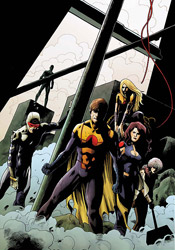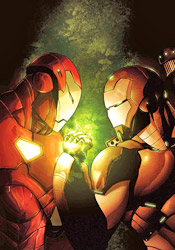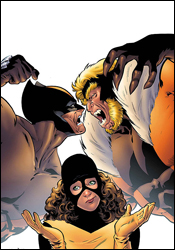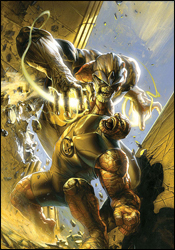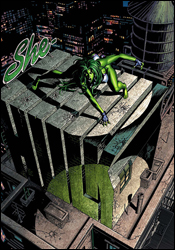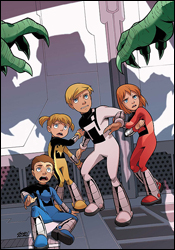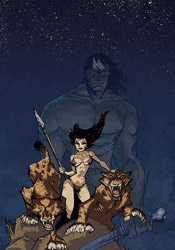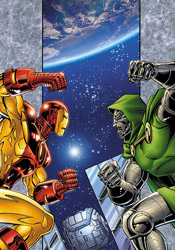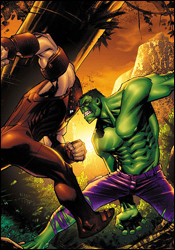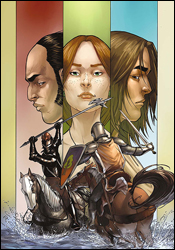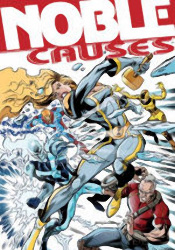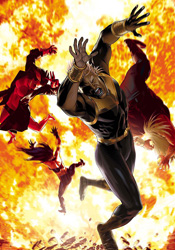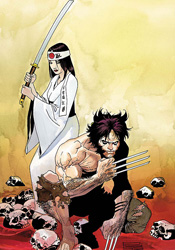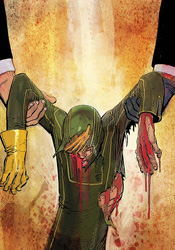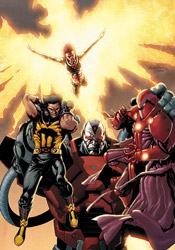
Writer Robert Kirkman has certainly strayed from the beaten path with his depiction of Ultimate Apocalypse, and I can't fault him for that. The Ultimate line was founded on the promise of old stories retold against an all-new backdrop, and he's taken that to heart here. His Apocalypse is truly fearsome and intimidating in a way that's completely different from his cousin in the 616 universe. He's also written the character, for whom I've long held disdain, into a corner with another of my least favorites (the Phoenix) and come out of it smelling like roses. I don't have a lot of time for all-powerful monsters in comics, especially when they've been overused like these two, but their conflict here leaves the X-Men in an unusual “damned if I do, damned if I don't” situation.
So the plot is good by me, although the actual storytelling falls a bit short. The battle between Phoenix and Apocalypse plays out like a turn-based RPG, each character shouting something impressive and then cutting loose with an assault while the other just stands there and takes it. Kirkman's dialog is quite stilted, even for the characters who aren't universe-devouring entities, and seems much more concerned with looking cool than with progressing the story. It's give and take throughout the issue, really – every good counter-balanced by a bad and vice versa... and the story's ending is the cop out of all cop outs.
Harvey Tolibao's artwork is so focused on detail that I had trouble following the narrative from cover to cover. His panels are so meticulous, so overfilled with teeny tiny little lines, that they often overflow into one another. This work is busy to a fault, detailed above and beyond the point of reason, and while it can occasionally work to his benefit, the sacrifices he makes in the issue's legibility aren't worth the trade-off.
If that weren't enough, Tolibao's odd take on anatomy and his characters' musculature makes his artwork even more off-putting. While his characters are very clearly three-dimensional, impressively weighty and sufficiently dramatic, they're just far enough off the beaten path to be unsettling. Never is this more evident than in his depictions of the Phoenix, whose appearance is basically a buck-ass naked orange Jean Grey sans her naughty bits. Here's a character whose design is body and nothing more, and her form is so far from that of an actual person that it's hard to imagine she's even human. His characters' muscles are oddly shaped, their bodies curved in places where they shouldn't be... it's borderline grotesque. And, if his rendition of Phoenix is bad, his take on the men is flat-out rotten. Every possible inch of flesh is coated with a spider's web of veins, accentuated by an amount of muscle that's so gratuitous, even a longtime pro wrestling / mixed martial arts / comic book geek such as myself has to look at it and shake his head. Steroids must run rampant in Xavier's mansion.
This issue has a lot of promise, but it fails to live up to that. The storytelling is largely good, but the limitations it displays are enough to keep it from reaching its potential. The artwork is gorgeous in a few specific moments (explosions and backdrops, largely) but is generally well below my expectations for one of Marvel's premiere titles. Come the perfect storm of a great artist and a plot that finally manages to execute, Ultimate X-Men could finally return to greatness. Right now, though, that moment seems like it's still quite a ways off. Skip this - the bad far outweighs the good at the moment, and it's not something new readers are going to want to dive into.
Overall Score: 3
